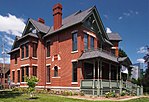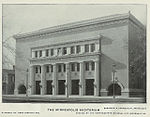Abbott Hospital

Abbott Hospital is a former hospital building in the Stevens Square neighborhood of Minneapolis, Minnesota, United States. The hospital was originally built in 1910, with several additions up until 1958. The hospital eventually merged with Northwestern Hospital in 1970 to form Abbott Northwestern Hospital, and the Abbott Hospital building closed in 1980.While the Abbott Hospital building is a contributing property to the Stevens Square Historic District, a separate listing was desired for the hospital because of its significance within the development of the health care system in Minneapolis. For that reason, a separate nomination was prepared and submitted, and the hospital was listed on the National Register of Historic Places on June 1, 2011.: 8
Excerpt from the Wikipedia article Abbott Hospital (License: CC BY-SA 3.0, Authors, Images).Abbott Hospital
East 18th Street, Minneapolis
Geographical coordinates (GPS) Address Nearby Places Show on map
Geographical coordinates (GPS)
| Latitude | Longitude |
|---|---|
| N 44.965555555556 ° | E -93.276111111111 ° |
Address
Abbott Apartments
East 18th Street
55403 Minneapolis
Minnesota, United States
Open on Google Maps










